Memory Beta, non-canon Star Trek Wiki
A friendly reminder regarding spoilers ! At present the expanded Trek universe is in a period of major upheaval with the continuations of Discovery and Prodigy , the advent of new eras in gaming with the Star Trek Adventures RPG , Star Trek: Infinite and Star Trek Online , as well as other post-57th Anniversary publications such as the ongoing IDW Star Trek comic and spin-off Star Trek: Defiant . Therefore, please be courteous to other users who may not be aware of current developments by using the {{ spoiler }}, {{ spoilers }} OR {{ majorspoiler }} tags when adding new information from sources less than six months old (even if it is minor info). Also, please do not include details in the summary bar when editing pages and do not anticipate making additions relating to sources not yet in release. THANK YOU
- Memory Beta articles sourced from games
- Memory Beta articles sourced from reference works
- Memory Beta articles sourced from episodes and movies
- Memory Beta articles sourced from novels
- Memory Beta continuity database
- Humanoid species
- Races and cultures
- Alpha and Beta Quadrant races and cultures
- Beta Quadrant races and cultures
- Rigel system races and cultures
- Vulcanoid species
- View history
- 4 Early Voyages continuity
- 5.1 Background
- 5.2 External link

Biology [ ]
They were a large and physically powerful people with an average height of over 2.5 meters and weighed over 150 kilograms. ( TNG - Intelligence Gathering comic : " A Matter of Dates "; FASA RPG module : The Orions: Book of Common Knowledge )
The Kaylar were noted for their aggression and were capable of a battle-frenzy that made them hard to stop with non-lethal weapons. ( TNG - Intelligence Gathering comic : " A Matter of Dates "; FASA RPG module : The Orions: Book of Common Knowledge )
There were thought to be only around 100,000 Kaylar across Rigel VII in the late 23rd century . ( FASA RPG module : The Orions: Book of Common Knowledge )
Culture [ ]
The Kaylar of Rigel VII were rated D-plus on the Richter Scale of Culture ( ST references : Star Trek Maps , The Worlds of the Federation ), known as primitive and savage, while their civilization was limited to towns, some agriculture. ( FASA RPG module : The Orions: Book of Common Knowledge )
The Kaylar preferred to be nomadic and unsettled however, and slaves and mercenaries soon fell back to this state when their owners' empires collapsed. ( Decipher RPG module : Worlds )
They were strongly territorial and xenophobic, and by the late 23rd century there had never been a successful contact that didn't end in bloodshed. The Kaylar preferred their solitude. ( FASA RPG module : The Orions: Book of Common Knowledge ; ST reference : The Worlds of the Federation )

Aton , a 24th century Kaylar.
Their most advanced weapons were catapults, swords, spears ( FASA RPG module : The Orions: Book of Common Knowledge ) and other primitive hand weapons ( Decipher RPG module : Worlds ). Kaylar warriors and construction workers mid- 24th century wielded large swords and axes in addition to energy weapons . ( TNG - Intelligence Gathering comic : " A Matter of Dates ")
They were expert in the ways of Rigel VII's powerful and erratic tides, however, and many were skilled mariners. They could sail across the dangerous oceans on ships that were huge in size but quite light, long, narrow, and shallow-bottomed. They were also known for skills in construction. ( FASA RPG module : The Orions: Book of Common Knowledge ; TNG - Intelligence Gathering comic : " A Matter of Dates ")
The Kaylar also typically had heavily decorated left arms. ( TNG - Intelligence Gathering comic : " A Matter of Dates ")
History [ ]
The Kaylar were suspected to be originally native to Rigel V , but were taken as mercenaries and slaves and settled on Rigel II , IV , and VII , where they quickly returned to nomadic life-styles once their masters' empires collapsed. ( Decipher RPG module : Worlds )
In 2254 , a USS Enterprise landing party under the command of Captain Christopher Pike was attacked by the Kalar on Rigel VII. Two crewmen were killed in the attack, while one, Yeoman Zac Nguyen , was presumed dead but was in fact left behind on the planet. ( TOS episode : " The Cage "; SNW episode : " Among the Lotus Eaters ")
The memory of the Kaylar attack was used by the Talosians when they held Captain Pike of the Enterprise captive. To help draw Pike into the illusion his fellow captive, Vina , purposefully overplayed her role as damsel-in-distress to keep Pike from rationalizing the experience, too distracted defending her from the attacking Kaylar. ( TOS episode : " The Cage "; TOS novel : Burning Dreams )
In 2259 , the Enterprise revisited Rigel VII, where Pike found out that Nguyen survived and became a leader of the Kalar as "High Lord Zacarias". ( SNW episode : " Among the Lotus Eaters ")
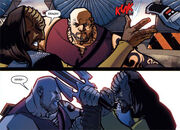
Administrator Areen battling Lieutenant Worf.
In the 2360s , a group of over two hundred Kaylar, led by Administrator Areen , were involved in a joint venture with a group of unrelated Rigelians to establish a new Federation colony on the planet Votar VII . The Kaylar were contracted to provide construction and repair services for suitable compensation. In 2368 , the Rigelians attempted to renegotiate their contract with the Kaylar laborers and tried to force a lower rate of compensation upon them. The Kaylar refused the terms of the new contract and in response launched an attack on a dam and a power planet, "repossessing" the facility, and cutting the power it provided, plunging the colony into darkness.
The Rigelians believed that the Kaylar would destroy the dam if their demands weren't met, and prepared to abandon the colony. As Votar was a strategically important location to the Federation, Starfleet sent the USS Enterprise -D to mediate the dispute. Early attempts at diplomacy and a non-lethal assault led by Worf were met with resistance from the Kaylar as the Rigelians had convinced them the Federation would side with them and force the Kaylar out. Meanwhile, the Kaylar had no intention of destroying that which they'd built. Once these facts came to light, Worf was able to clear the waters and bring both sides to the negotiation table to find an amicable resolution to their dispute. ( TNG comic : " A Matter of Dates ")
Early Voyages continuity [ ]

After centuries of specialized breeding, the Kaylar developed to be quite different from the average Rigellian , being a good deal taller and stronger. ( EV comic : " Our Dearest Blood ")
Historically, the Kaylar played a major part in Rigel's warlike society. ( EV comic : " Our Dearest Blood ") In the 2250s , when Rigel VII sought to join the United Federation of Planets , the Kaylar faced being disbanded as Rigel attempted to move its society forward from its warlike routes. The Zemtar fortress , a traditional Kaylar barracks, was to be the site of Rigel VII's admission ceremony. ( EV comic : " Our Dearest Blood ")
However, Rigel VII did not join the Federation due to a Kaylar coup on the eve of the planet's admission. The Kaylar attacks lead to the deaths of three crewpersons from the USS Enterprise and injuries to seven others. The incident shocked much of Rigellian society, spurring them to continue their reformations, to remove the more barbaric elements of their society with the aim of eventually reclaiming its place in the Federation. ( EV comics : " Our Dearest Blood ", " Nor Iron Bars a Cage ")
Appendices [ ]
Background [ ].
There have been differing depictions of Kalar or Kaylar over a number of sources. The ST references : Star Trek Maps , The Worlds of the Federation , Star Charts describe the "Kalar" or "Kaylar" as the dominant species of their homeworld, but describe them as primitive and pre-industrial, and have Rigel VII be an avoided and quarantined world (likely by the Prime Directive ) after failed first contacts. The Decipher RPG module : Worlds follows suit, but places on several worlds of the Rigel system , having them be the descendants of slaves and mercenaries deposited there by ancient masters (by context, these are likely to be of the Orion Empires ).
TNG comic : " A Matter of Dates ", set in the 24th century, has them as a somewhat civilized warrior people in their own right, employed in Federation colony construction, indicating a century of advancement. It also depicts Kaylar of much more typically humanoid sizes than in other appearances before SNW , which also has depicts them as identical to Humans.
On the other hand, the EV comic : " Our Dearest Blood " makes the Kaylar merely a sub-culture of the more advanced Rigelians, prospective Federation members at the time others place first contact.
External link [ ]
- Kaylar article at Memory Alpha , the wiki for canon Star Trek .
- 1 Ferengi Rules of Acquisition
- 2 The Chase
- 3 Preserver (race)
Celebrating the best of tv, movies, and comics
Star Trek: Strange New Worlds goes back to the beginning with this ferocious alien race
Captain Pike must confront the aliens that caused one of his greatest defeats.
Season two of Star Trek: Strange New Worlds has called back to different parts of the Star Trek Universe in different ways. Sometimes, the show does so with fun Easter eggs like Spock's Vulcan Lute or the reappearance of the Department of Temporal Investigations . Other times callbacks to the past can drive the narrative like with La'an Noonien-Singh wrestling with the history of her ancestor, Khan . This week, we go back to the very beginning of the Star Trek franchise as the show revisits a fearsome alien race.
The real problem begins five years prior to Star Trek: Strange New Worlds, when Captain Pike and a landing party embarked on a routine expedition on the Class M planet Rigel VII. The local inhabitants consisting of primitive humanoids ambushed them, and during the hasty retreat of Pike and his crew, the crew may have left their equipment behind. This is an issue because it could be a breach of the Prime Directive, Starfleet's principle of not interfering with the natural development of alien civilizations.
Now, when aerial imagery of the planet detects structures resembling the Starfleet delta insignia, the Enterprise is sent back to clean up their mess and assess the level of cultural contamination they may have caused. As for Pike, he has reservations about returning to Rigel VII because of his experience with the formidable indigenous people known as the Kalar.
What happened during Captain Pike's first encounter with the Kalar?
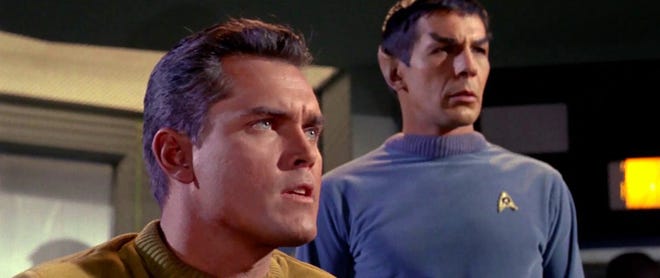
The behind the scenes lore regarding Pike's first encounter with the Kalar is pretty interesting. The events of that encounter are first recounted in the very first pilot of Star Trek the original series (TOS) entitled 'The Cage.' After the initial viewing, the executives at NBC were not satisfied and reordered a second pilot, which would be the one to air and become the Star Trek that we know today. However, footage from 'The Cage' would be incorporated into the two-part 'The Menagerie,' which are episodes 11 and 12 from season 1 of TOS.
We actually never see what happens on Rigel VII, but hear the story from Pike as he opens up to his chief medical officer, Dr. Boyce, in the unaired pilot. On the planet, Pike led his landing party into a trap set by the Kalar. The failed mission resulted in the death of three of his crew and seven more injured, including Spock.
The traumatic event has a significant impact on the captain. He wrestles with guilt and feels responsible for the loss of his crewmen. In the episode, Pike even considers resigning from Starfleet, though the good doctor talks him out of the rash decision.
Who are the Kalar of TOS?
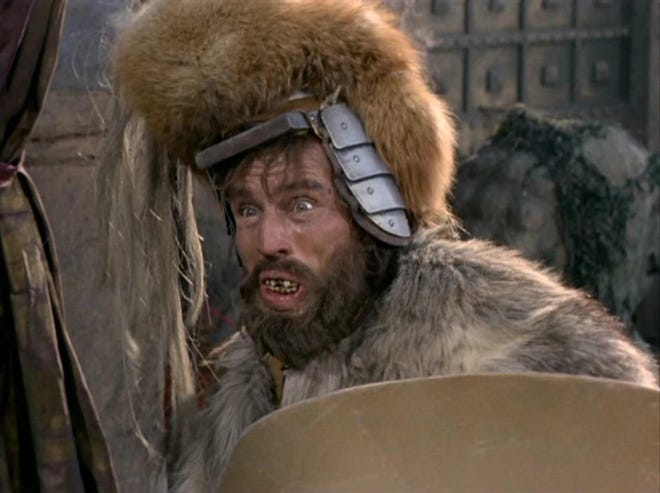
The Kalar are a primitive humanoid species native of Rigel VII. These people are slightly larger than a human and are fierce warriors, but they are not as advanced and often fight using antiquated equipment such as swords, spears, shields, and armor. Despite their inferior technology, they are still able to catch the Starfleet members off guard and inflict great damage.
Though the story of Kalar encounter is only verbalized, we do catch a glimpse of one in 'The Cage.' In the unaired episode, Pike is manipulated by telepathic aliens called Talosians to make him fall in love with a woman named Vina. One illusion involves Pike saving Vina, under the guise of a Rigellian princess, from a Kalaran warrior.
Who are the Kalar in Star Trek: Strange New Worlds?
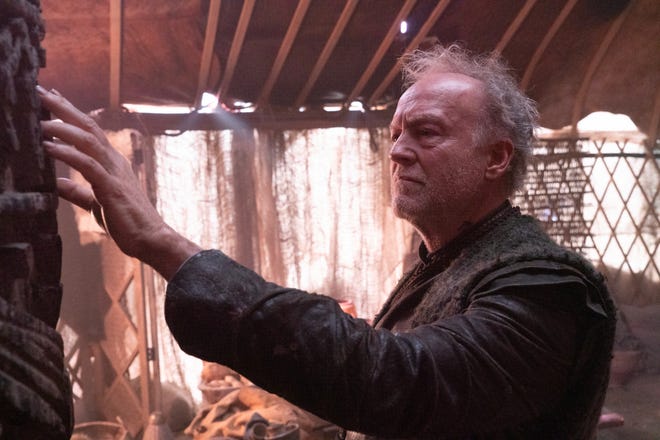
Star Trek: Strange New Worlds expands on the alien race first seen in TOS. The Kalar are described as a bronze age society organized in a caste system. They contain a formidable warrior class hardened by the planet's harsh conditions called the field Kalar and a secretive ruling class called the palace Kalar. According to the ancient stories, the former are unable to retail their memories (and are used as forced laborers), while the latter retain their memories and are responsible for planning the future and recording the past.
The field Kalar are organized based on their particular job set. They are able to keep their implicit memory such as walking and talking while their explicit memories including who they are and where they live go away each day. Yet they do find ways to guide themselves in their regular activities. They are a close-knit community and help each other manage the memory loss. The field Kalar use the oils of their fruit of the gods to tattoo themselves with their important personal information. In addition, they keep a totem of their people's story inside their homes.
Why are the Kalar so underdeveloped?
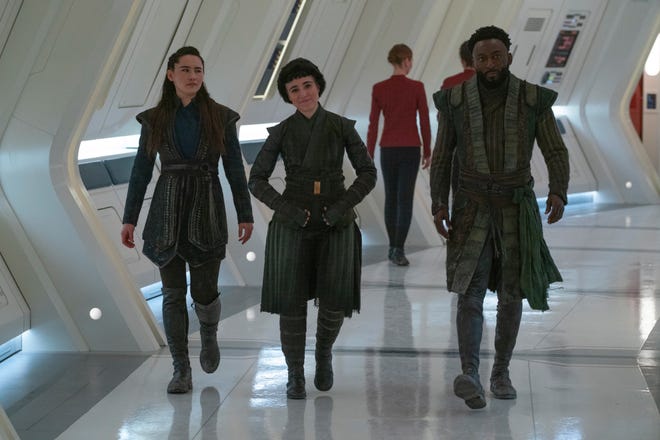
Thousands of years ago, an asteroid landed on Rigel VII. It contained a form of radiation that causes synaptic degradation of the frontal, parietal, and temporal lobes. As a result, the Kalar experience explicit memory loss while their implicit memories such as instinct and emotion are left intact. This neurological condition stunted the development as a people, hence their primitive existence in comparison to Starfleet. The palace Kalar are able to reduce their exposure due to the castle's structural materials and their natural properties that can shield the radiation.
What is the fate of the Kalar in Star Trek: Strange New Worlds?
The Kalar are introduced to modern technology by their leader High Lord Zacharias. This High Lord turns out to be Pike's yeoman, Zack Nguyen, long believed to be dead. Zack survived the initial ambush years ago, and gathered the Starfleet gear left behind including phaser rifles to help fuel his rise in power. With the superior arsenal, it wasn't too long until he became ruler. As a sign of reverence, the Kalar erected the structures bearing the symbol on his uniform, the Starfleet delta insignia.
Eventually, Pike and the rest of the Enterprise crew are able to overcome and negate the effects of the radiation. They also able retrieve all of their old tech to clean up their previous cultural contamination, and take Yeoman Nguyen into custody. As a parting gift for the meddling in Kalar affairs, the Enterprise removes the asteroid from the planet allowing the natives to develop unhindered by its effects; an act which some might say disobeys the Prime Directive.
For more on Star Trek and how to understand it all, we have a comprehensive Star Trek watch guide
MCM Comic Con
Florida Supercon
Comic-Con International: San Diego
New York Comic Con
- Spacefaring Civilizations
- Races of the Rigel System
- Bipedal Species
- Species with Binocular Vision
- Clawed Species
- Mono-Gendered Species
- Oviparous Species
- United Federation of Planets
- Movie Species
- Live Action Species
Rigellian (Star Trek)
- View history
Behind the scenes [ ]
The Rigellians appeared unnamed in Star Trek: The Motion Picture , their only canonical appearance so far, but have been mentioned in multiple Star Trek series. The information on their biology and evolution comes from designer Robert Fletcher.
In Star Trek , the Rigel system is also home to a savage humanoid species known as the Kalar from Rigel VII, making it possible that the information about Rigellian blood being similar to Vulcans (from "Journey to Babel") and/or their being susceptible to the Romulan disease (as mentioned in Deep Space Nine ) might actually refer to the Kalar. Apparently human characters in the episodes "Shore Leave" and "Wolf in the Fold" have been identified as native to Rigel II and Rigel IV respectively, indicating that there are human colonies on these worlds. Rigel X, as seen on Star Trek: Enterprise , is inhabited by an extremely diverse multi-species community. Rigel XII is a scarcely-inhabited mining colony, as seen in "Mudd's Women".
To make matters more complicated, a humanoid species seen on later Star Trek: Enterprise has been identified as Rigellians, despite the fact that they look very dissimilar to the chelonian creatures from The Motion Picture . It is possible that these represent an immigrant species which was misidentified as native Rigellians in the 22nd century and the system was later reclaimed by the chelonians, but this is just speculation. It is also possible that they represent a different native Rigellian species, or even a different ethnic group or caste which belongs to the same species as the reptilian Rigellians. However, Dr. Phlox once mentioned the Rigellians as a species with four or five genders, contradicting Fletcher's claim that Rigellians are mono-gendered, and therefore strongly suggesting that Enterprise 's Rigellians are not the same species as this one.
In non-canonical media, the Rigellians are referred to as the Chelons , from Rigel III. According to the Star Trek expanded universe, there are six native species to the Rigel system: the Chelons or Chelarians from Rigel III, the human-like Rigelians (Kalar warriors) from Rigel VII, the Enterprise Rigelians, a race of Vulcanoids from Rigel V (the ones referred to in "Journey to Babel"), a rat-like species from Rigel IV, and a silver-skinned humanoid species also from Rigel IV.
The Saurian action figure produced by Mego was incorrectly marketed as a Rigellian.
- 1 Trisolaran
- 2 Xenomorph
- 3 Tarantian
L'ak's Species Revealed In This Week's Star Trek: Discovery Episode 'Mirrors'
A huge addition to Star Trek lore.
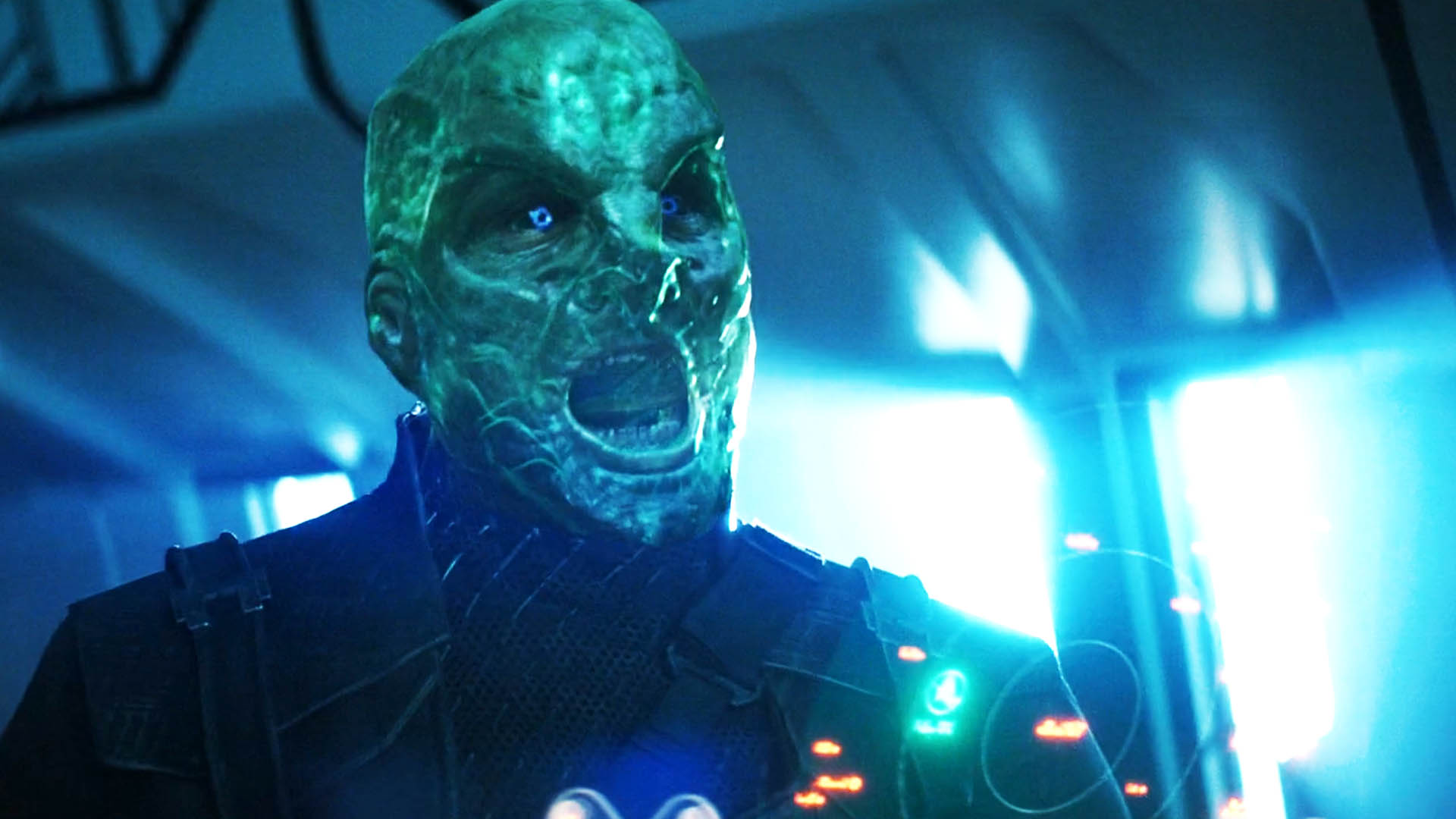
I'm intrigued by how L'ak's face changes into a solid state when he first takes of [sic] his helmet in #StarTrekDiscovery's "Red Directive".
I did that on set. I can morph my own face. I'm very talented.
Jack Kiely is a writer with a PhD in French and almost certainly an unhealthy obsession with Star Trek.
Suzie Plakson
IMDbPro Starmeter Top 5,000 1216

- Contact info

- 1996 • 1 ep

- Mary Anne Hunter

- Senior Flight Attendant

- Judy Eriksen
- 15 episodes

- Rosalind Bassa

- Jesse Bates

- Dr. Ingrid Chekhov
- Chief of Staff Nan Fleming (voice)

- Janet Bellamy

- Amazonian (voice, as Susie Plakson)

- Jane Holcombe

- Joanne Glotz
- Joanne 'Cinnamon' Glotz

- Dr. Joan Golfinos
- Dr. Joan Herman
- 17 episodes

- Tammy (voice) ...
Personal details
- Official Site
- Susie Plakson
- 6′ 1½″ (1.87 m)
- June 3 , 1958
- Buffalo, New York, USA
- Relatives Barbara Berger (Sibling)
- Other works (theater) "La Bete" (1991) as Marquise Therese Du Parc
- 1 Interview
- 2 Magazine Cover Photos
Did you know
- Trivia The only actress to appear as 4 different aliens in 3 different "Star Trek" series: Vulcan Lieutenant Selar and Klingon K'Ehleyr on Star Trek: The Next Generation (1987) , the female Q on Star Trek: Voyager (1995) and Tarah, the first female Andorian on Star Trek: Enterprise (2001) . Although, actor Jeffrey Combs exceeded her with 6 different aliens over 3 series: Tiron, Brunt and Weyoun on Star Trek: Deep Space Nine (1993) , Penk on Star Trek: Voyager (1995) , as well as Krem and Commander Shran on Star Trek: Enterprise (2001) .
- Trademarks Statuesque, model-like figure
- How old is Suzie Plakson?
- When was Suzie Plakson born?
- Where was Suzie Plakson born?
Related news
Contribute to this page.
- Learn more about contributing
More to explore

Add demo reel with IMDbPro

How much have you seen?

Recently viewed
Den of Geek
Star Trek Just Addressed One of Deep Space Nine’s Biggest Unanswered Questions
The Star Trek: Discovery episode "Mirrors" includes a HUGE reveal about the Breen, an odd alien species from Deep Space Nine.

- Share on Facebook (opens in a new tab)
- Share on Twitter (opens in a new tab)
- Share on Linkedin (opens in a new tab)
- Share on email (opens in a new tab)
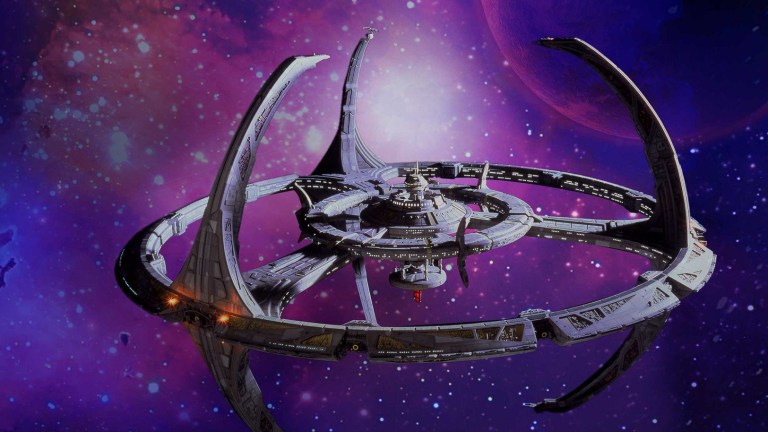
This Star Trek: Discovery article contains spoilers.
“I wonder what the Breen look like under those helmets?” asks Ezri Dax in the Deep Space Nine season seven episode “‘Till Death Do Us Part.” That’s a strange question, given that Ezri and Worf had been captured by the Breen and interrogated for some time. But despite their close and uncomfortable contact with the hostile alien species, neither hostage learned much about them.
“They say no one has ever seen one and lived to speak of it,” Worf answers.
Ezri continues in her usual lighthearted manner. “Maybe they’re all furry. It’s supposed to be very cold on Breen.”
Ad – content continues below
“One thing is certain.”
“They’re horrible cooks?”
“They are dangerous,” responds Worf, with even greater gravity than the Klingon usually assumes. “They do not tolerate incursions into their space. During the Second Empire, Chancellor Mow’ga sent a fleet of Klingon ships to conquer their homeworld, and they were never heard from again.”
Until today, that bit of dialogue encapsulated everything that Trekkies knew about the Breen. First mentioned in The Next Generation, the Breen appeared most prominently in the final season of Deep Space Nine , in which the Breen presented a threat that undid whatever gains the Federation had made in the Dominion War.
When the Dominion first entered the Alpha Quadrant through a wormhole from the Gamma Quadrant, they threatened to immediately overwhelm the Federation. As a result, the Federation had to align with longtime antagonists the Klingon Empire and the Romulan Star Empire. That confederation was more than a match for the Dominion/Cardassian alliance, but then the Dominion upped its hand by enlisting the terrifying Breen. It would take a miracle for the Alpha Quadrant forces to win. Fortunately, the Federation had a miracle on its side in the form of the Prophets (and the morally flexible Section 31 ) and won the war.
The Breen rarely appeared after Deep Space Nine concluded, and it’s easy to see why. They felt like they came from another universe, even moreso than the alien oddities that often appeared on Star Trek . With their monocular helmets and gravelly, indistinguishable voices, they felt like something out of Star Wars — specifically, they felt like riffs on Princess Leia’s bounty hunter disguise at the start of Return of the Jedi . Although they get a couple of nods in Voyager and, of course, Lower Decks , the Breen were largely relegated to a handful of non-canon novels.
That is, until the Star Trek: Discovery season five episode “ Mirrors .” In that episode, we finally learn that L’ak, a courier who has been chasing past Discovery in a search for Progenitor tech with his partner Moll, is a Breen who doesn’t wear helmet that hides his face, showing us for the first time what the species actually looks like under the armor. That’s a surprise because L’ak appeared to be just a regular green-skinned alien, a little lizard-esque in appearance, almost like a Reptilian Xindi from Enterprise .
Get the best of Den of Geek delivered right to your inbox!
In fact, “Mirrors” does a lot more than just show us the face of the Breen. We also learn more about their culture, getting a sense of why they refuse to use a Universal Translator in conversation with other races and of their political system. In a move that recalls another Star Wars property, The Mandalorian , the Breen consider their helmets their true faces, and in fact have a transparent look when they remove that helmet.
But as L’ak makes clear, the Breen have the capacity to change, something hinted by the warmth and softness performer Elias Toufexis brings to his imposing character. Not only has L’ak made his skin non-translucent, but he’s adopted Federation Standard (aka English) and moved beyond his hierarchical culture.
Those changes are a good thing, because the Breen have always created problems for Star Trek canon. As many fans have noted, although Worf insisted that no one had seen the Breen under their costumes, Kira and others stole Breen uniforms to move behind enemy lines at one point on the series. They must have gotten a glimpse of the Breen then, right?
For Ronald D. Moore , one of the key creatives during the ’90s Star Trek era, that’s not necessarily the case. “There’s nothing in those helmets. I don’t think there’s a guy in there, which is something we never got around to saying,” Moore said in the Star Trek: Deep Space Nine Companion . “Or maybe there’s a little slug, some tiny little creature in there. I never wanted them to be humanoid in any way.”
“Mirrors” goes against Moore’s wishes then, but that shouldn’t be too much of a surprise. Discovery started its life by radically altering the Klingons. Looks like it will be ending its life by radically altering the Breen. But this time, it’s for the better.
Star Trek: Discovery is streaming now on Paramount+.

Joe George | @jageorgeii
Joe George’s writing has appeared at Slate, Polygon, Tor.com, and elsewhere!
- The Inventory
Love Is Always the Answer on Star Trek: Discovery
"mirrors" sits our heroes and villains alike down in a surprising setting, to come to a conclusion discovery has come to many times before..
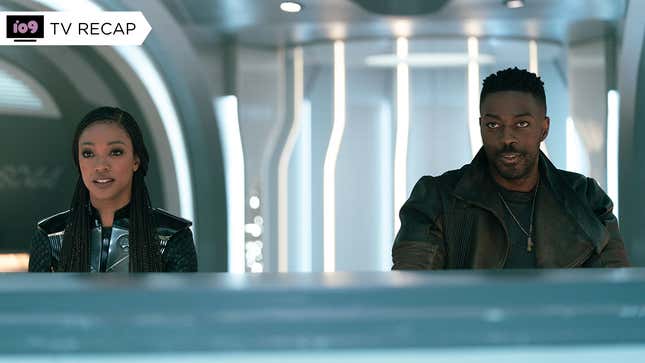
We’ve said this many times before, and will no doubt say it a least a few times before as it nears its final end this season: Star Trek: Discovery is not a subtle show . It never has been, but ever since it really found its confidence and understood where its strengths were, it has never shied away from yelling them loudly in the audience’s faces.
Related Content

Sometimes this works in Discovery ’s favor, like it did in last week’s stunningly tight time-twisting adventure—the show firing on all cylinders to play with a format it knows it’s really good at, and using it to do the character reflection it’s also really good at. Sometimes, it means you get an episode like this week’s “Mirrors,” a perfectly perfunctory episode that ties together three different stories—that needed to be told at this point in the season , so you might as well shove them all into the blender and get it out at once—under a familiar dramatic message: Discovery loves Love. It loves romantic love, it loves the love between friends, it loves the bonds love creates to help people change and grow. You, the protagonist: have love! You, the villains of the arc: have love! You, the background support crew: have some love, too!
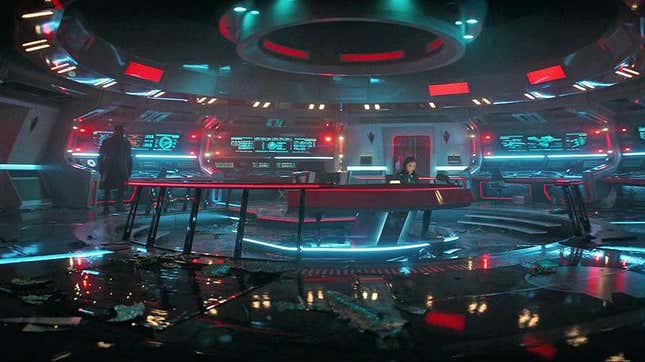
You know what else this season of Discovery also loves, apparently? Set re-use. After the premiere gave us some clever re-dresses of Discovery hallways and rooms to become the Romulan science ship that kickstarted this whole race-for-progenitor-tech off in the first place, and last week cleverly used the time-hopping conceit to dress and re-dress Discovery again for different eras of the show, this week Michael and Book take themselves on an inadvertent crossover with Star Trek: Strange New Worlds , but not like Lower Decks did. More so that they’re simply just on the Enterprise sets instead! After discovering that Moll and L’ak are hiding out with the next clue in the pocket of extradimensional space—safeguarded by a rapidly opening and closing wormhole entrance—Michael races into action to find them, leaving Commander Rayner in charge back on Discovery and dragging Book along with her, where they discover that the duo, and the clue they seek, is hiding out in the damaged, abandoned remnants of the ISS Enterprise : the Mirror Universe version of the iconic ship.
Alas, Discovery really doesn’t do much to interrogate its own history with Trek ’s famous alt-reality; at this point in continuity, Discovery has previously told us, it’s now truly separated from the prime reality, having interdimensionally drifted to the point there’s not been crossover for centuries. Discovery also doesn’t even really explore what it means that the most iconic version of Starfleet’s flagship, twisted into its Terran Imperial form, is now just hanging around, not just as ancient 23rd century technology but filled with materials not of this reality. Sure, at the end of the episode it’s how everyone escaped the destabilizing extradimensional pocket, and Michael taps Owosekun and Detmer to go drag it back to Starfleet for preservation. But really, the ISS Enterprise is here for set dressing: it is the arena in which “Mirrors” dumps its boatload of backstory to fill us in on what’s driving Moll and L’ak.
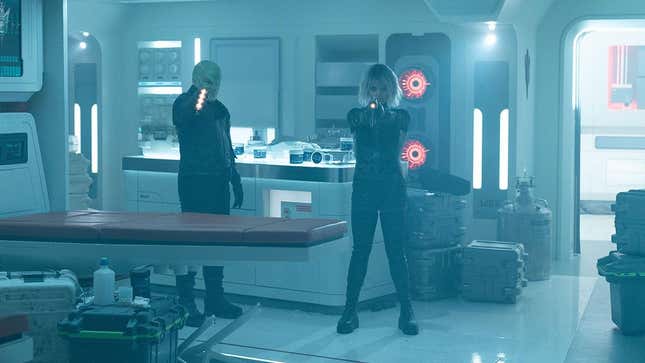
That is, at least, the interesting thing about “Mirrors”—while it is unsurprising that it turns out Moll and L’ak’s story is about two people cast aside by their societies and former families who find strength and love in their connection, the show does at least give some interesting twists to it all. It turns out L’ak is in fact a member of the classic Trek species the Breen, and cast-out royalty at that, giving an interesting bite to the idea floated last week that it could be them who they ultimately sell the Progenitor tech to should they get their hands on it. It’s also necessary at this point in the season, half-way through, that, well, we actually get motivations for our villains beyond them just getting the thing our heroes want: L’ak has a Breen blood bounty on his head for betraying his people to be with Moll, and all they want is just the opportunity to be free and together and live a life that they define.
It’s interesting! It’s well done! It’s a nice twist for the villains to not just be antagonists for antagonism’s sake! But the show does have to get this all out by slamming the proverbial brakes on its adventure—which happened last week already, but happened last week to give us a really smart use of a classic Star Trek storytelling structure to tell a story that Discovery could only tell knowing it was coming into its final journey, to look back on how far it had changed. Here, the brakes are slammed on to dump a bunch of flashbacks to one specific Breen hangar while our characters hang out on the dimly lit Strange New Worlds backlot. And it’s what we get in the other threads of “Mirrors” too—as we see Michael and Book reflect on their own past together, while Book tries (and regularly fails) to connect with Moll over their shared connection to Booker the Fourth, and as, back on Discovery , we see Rayner try to bring together everything he’s learned about working with this crew to help pull its captain back out from the breach when things start going sideways.

Alone, these are all interesting and necessary kernels of ideas, but mushed together into one story to once again smash over our heads that Connection, Understanding, and Love For Each Other Are Good undermines those ideas a little, and renders them clunkily explored in their own ways. Moll and L’ak largely escape this unscathed as “Mirrors” gives most of itself to their backstory. But that in and of itself feels clunky because it means the thread with Michael and Book half-heartedly acknowledging each other just in case they die feels like an addendum rather than a satisfying point in their shared arc. It means back on Discovery, with barely any time to spare for Rayner’s first big command test without Burnham, we go from knowing absolutely nothing about his Kelleran culture to us and everyone on the ship knowing about five or six different allegedly important parts of its cultural tapestry that it turns out are fundamental to understanding Rayner as a person too. (Admittedly, this is also a Star Trek classic— Trek loves pointing at a single member of a species and tying their entire sociopolitical or theological systems to our understanding of their character.)
Ultimately, it just leaves “Mirrors” as a series of interesting parts that, as a whole, are simply fine. At the end of the day, everyone gets out the extradimensional pocket fine, Mol and L’ak get to half-heartedly escape, and the quest can continue. It’s just now we all know all these characters just want love in the end , and perhaps, most likely—because this is Discovery and it’s what it loves to do most—in the end, the vast majority of them will get it. Necessary stage setting perhaps for this season, but after such an incredible way to center those ideas in the legacy of the show last season, all this feels a bit more like a bump in Discovery ’s road.
Want more io9 news? Check out when to expect the latest Marvel , Star Wars , and Star Trek releases, what’s next for the DC Universe on film and TV , and everything you need to know about the future of Doctor Who .
Advertisement

Navigation menu
- Mission Logs
- Chronologies
- Library Computer
Kalar Warrior
Captain Christopher Pike was forced to fight this unnamed Kalar warrior during a disastrous first contact mission in 2254 . When he was captured by the Talosians , Pike was then forced to relive the encounter. [1]
Notes and References
- ↑ Roddenberry, Gene (Executive Producer). "The Cage" . Star Trek , season 0, episode 0 (Production number 01). Directed by Robert Butler . Written by Gene Roddenberry . Released 1986 . Desilu Productions . 1965 .
- Prime Timeline
- Privacy policy
- About Trekipedia
- Disclaimers
- Login / Create Account

Star Trek: Discovery Finally Gave Us A Closer Look At The Franchise's Most Mysterious Villain
Warning: This article contains spoilers for the latest episode of "Star Trek: Discovery."
"Star Trek" might represent an idealistic vision of a bolder and brighter future, but the last few seasons of "Discovery" have proven that there will always be bad guys with a penchant for muddying up those ambitions in unexpected ways -- even in the 32nd Century. While the Borg, Romulans, and the warlord Khan often have a stranglehold on the title of "Best 'Trek' villains," one alien species in particular has remained shrouded in mystery for decades. First mentioned in foreboding whispers in "The Next Generation" and finally seen in the flesh (well, so to speak) in "Star Trek: Deep Space Nine," the Breen have played a significant role throughout the franchise in the years since ... yet Trekkies still had to wait until now to actually see what lies underneath their distinctive helmets.
The advantage of never showing us a Breen's face, as it turns out, is that "Discovery" was able to hide one in plain sight all along.
So far, the addition of scavengers Moll (Eve Harlow) and L'ak (Elias Toufexis) has felt like a shoe waiting to drop. The close-knit pair continue to frustrate Captain Michael Burnham (Sonequa Martin-Green) and the rest of the Discovery crew (nowhere more dramatically than in last week's time-traveling bottle episode ), remaining one step ahead of our heroes in their quest to recover whatever Progenitor technological treasure hides at the end of this galaxy-spanning rainbow. About midway through episode 5, titled "Mirrors," the writers unleashed their big twist. L'ak, thus far considered an unknown type of extraterrestrial, actually reveals himself as a Breen. Or, rather, an emotional Moll lets this information slip by accident during a particularly fraught moment. In the process, "Trek" finally unmasked its most enigmatic aliens.
Read more: Every Star Trek Show And Movie In Chronological Order
Putting On A Brave Face (Or Two)
In the span of one episode, "Discovery" officially made "Star Trek" history.
Long treated as a mystery that left everything up to our own imaginations, the Breen reveal puts a specific face to what had previously only been a name ... actually, make that two faces. While Moll and L'ak come to a tense faceoff with Burnham and Cleveland Booker (David Ajala) on board the mirror-universe version of the USS Enterprise while trapped in multidimensional space (it's a long story), the writers treat this as the perfect opportunity to delve into the scavengers' shared past. In a series of flashbacks, we find out that L'ak was part of the Breen royal family and disgraced by his powerful Primarch uncle. Hoping to earn his way back to his people's good graces, all his plans are upended by a torrid romance with then-courier Moll. With their backs against the wall and nowhere else to turn, the lovers choose their own path altogether and, along the way, L'ak reveals his most private aspect of himself: his Breen face.
Of course, the episode adds another twist and introduces the concept of the Breen having two faces -- a solid, corporeal form they can present to others if they so choose, and a more translucent one. (Really, it can only be described as squishier. ) In fact, this creepy and altogether unique visage symbolizes a much more meaningful difference, as we learn when L'ak's uncle calls his chosen face an "insult to your heritage." Apparently, most Breen have moved beyond this "weak" form and consider this some sort of societal faux pas. In just a few minutes, we discover more about Breen culture than we've ever known before.
New episodes of "Star Trek: Discovery" stream every Thursday on Paramount+.
Read the original article on SlashFilm
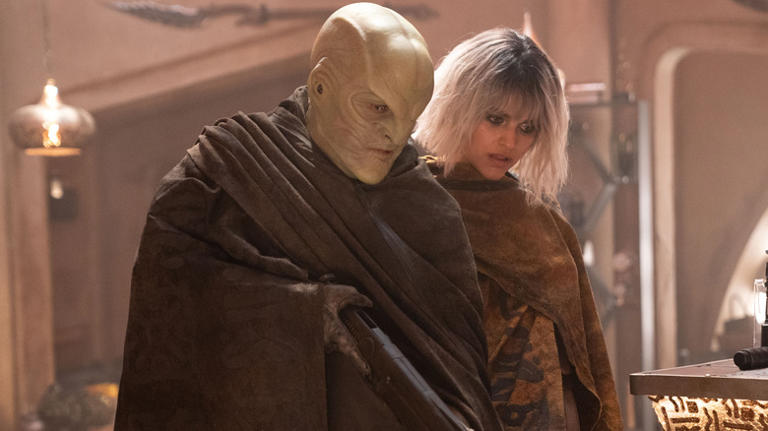
Star Trek: Discovery Season 5, Episode 5 Review: The Crew Solves Two of the Series’ Biggest Mysteries
While on the hunt for Star Trek: Discovery Season 5's powerful alien technology, Captain Michael Burnham solves two decades-old franchise mysteries.
The following contains spoilers from Star Trek: Discovery, Season 5, Episode 5, "Mirrors."
One thing about Star Trek: Discovery fans is they are very observant. The big surprise in Season 5, Episode 5, "Mirrors," was slightly spoiled by the trailers, particularly when these eagle-eyed fans captured and examined screenshots. While the return of the ISS Enterprise after 58 years is a big deal, there is more that happens in the episode than solving an old mystery from Star Trek: The Original Series . However, the answer that Captain Michael Burnham and Cleveland Booker uncover is a great one, and fans finally get a long-awaited first look at a mysterious alien species.
After dealing with the Time-Bug in the previous episode , the crew of the USS Discovery tries to figure out where Moll and L'ak disappeared to. While the space criminals have been very capable villains (almost too capable), they're not doing very well in the race. "Mirrors" marks the first time that Moll and L'ak put their hands onto one of the pieces of the Progenitors' puzzle before the Discovery crew. Of course, they aren't able to hold onto it for long after L'ak suffered a serious injury. Still, for the first time, both Burnham and Booker talk to their rivals, approaching them with the kind of compassion that Starfleet is known for. However, they still have to accomplish their mission, and L'ak's determination to be there for Moll gets in the way of any common ground they could've found. Thanks to flashbacks, viewers finally learn why the two are so eager to find this treasure, and where L'ak is coming from.
Star Trek: Discovery Season 5 Continues To Put the USS Discovery in Classic Star Trek Situations
“mirrors” shows the crew rising to meet the challenge in classic star trek fashion, star trek: discovery's callum keith rennie shows a new side of starfleet.
From the lack of galaxy-ending stakes and major interpersonal drama among the crew, Season 5 is Stark Trek: Discovery at its most fun. This episode, in particular, is full of classic Star Trek moments, from forcing enemies to work together to sci-fi technobabble that provides a dramatic resolution to a major problem. The impetus for this race for the Progenitors' technology stems from Star Trek: The Next Generation's "The Chase (Season 6, Episode 20)," but there are major connections to all eras of Gene Roddenberry's universe throughout the season.
While they don't get a lot of screentime, the USS Discovery's crew under Commander Rayner's authority is an equally interesting part of the episode. The recently-demoted captain is hesitant to take full command of the ship in a crisis. In "Jinaal (Season 5, Episode 3)," he took command while Burnham and the away team were down on the surface of Trill. Yet, as far as he knew, their lives and that of the crew weren't in serious danger. His focus was on finding Moll and L'ak, and personally connecting with the crew in 20 words or less. That's not to say that the stoic commander was above some of the series' most emotional beats.
An early scene in the episode, where Captain Burnham tells her new Number One that she believes in him, was subtle but touching . After Rayner showed that he studied Earth customs and sayings, such as "breaking the ice," Burnham returns the favor and cites a historical epic from the Kellerun people. This comes into play when she's able to reference that story later on as a distress call for herself and Book. Instead of badgering the crew, Rayner uses his newfound personal connections (and a friendly offer of Kellerun Citrus Mash) to inspire the crew to solve the problem. This was as classic a Star Trek moment as any, and one longtime franchise fans will surely love.
Star Trek: Discovery Season 5 Reveals the Face of the Breen Imperium Through Moll and L'ak
Star trek fans have wondered what the breen looked like under their armor for decades, star trek: discovery's mary wiseman, wilson cruz and blu del barrio hype finale.
First introduced in Star Trek: Deep Space Nine , the Breen Imperium was a galactic seat of power outside of Federation space who allied with the Dominion. The armored aliens look like something out of Star Wars , particularly their helmets, which were reminiscent of Princess Leia's Boussh disguise in Star Wars: Episode VI Return of the Jedi . The Breen's appearance and who they really were was one of the most enduring mysteries in Star Trek canon. Even the Dominion didn't know what their Breen allies looked like under the armor. Star Trek: Discovery finally reveals the armor keeps their bodies in a translucent, almost liquid-like state. L'ak, as viewers have seen them, are what the Breen call their "other face."
Moll originally teamed up with L'ak to cheat the Imperium out of some faulty dilithium, a commodity that became scarce because of the Burn . They soon fell in love and when L'ak's uncle, the Primarch of the Sixth Fleet, found out, he ordered L'ak to kill Moll. He instead killed his uncle's guards, but spared the Primarch because, as L'ak said, "he raised me." This defiance earned him an "Erigah," a Breen bounty that is impossible to lift. He now hopes that bringing the Progenitors' technology to the Primarch will lift this death sentence.
Moll also bonded with her quasi-brother Cleveland Booker, though he's the fourth to use that name. Her father was the third Booker, which made him desperate to "save" Moll. Knowing that all she really wants is to live a quiet life, "Mirrors" could be the start of Moll and L'ak eventually joining forces with the USS Discovery crew. Captain Burnham is, after all, a big fan of second chances and redemption . If Season 5 is to have a big villainous threat, it will clearly be the Breen trying to collect on L'ak's Erigah, not two petty criminals.
Star Trek: Discovery Season 5 Reveals What Happened to the Mirror Universe Enterprise
The iss enterprise was introduced in star trek: the original series “mirror, mirror (season 2, episode 4)”, star trek: discovery actors doug jones & david ajala prepare for their last adventure.
"Mirrors" also reveals another, older Star Trek secret, specifically the ultimate fate of the ISS Enterprise, formerly under the command of Tiberius Kirk . Previously, Star Trek: Deep Space Nine episode "Crossover (Season 2, Episode 23)" revealed what happened to the Mirror Spock and the Terran Empire. He started the revolution that Kirk suggested and was successful in conquering the Terran Empire to usher in galactic peace. Unfortunately, an alliance of Klingons and Cardassians attacked their weakened forces and took over the galaxy -- or at least the sector containing the Cardassian and Bajoran territory. The fate of Spock himself and his flagship was left open for other storytellers to explore.
Star Trek: Discovery still leaves Spock's ultimate fate an open question, though it seems unlikely that he would have fled his universe. His ship, however, became a refugee vessel for Terran reformers who fled, either in the face of Klingon-Cardassian attacks or a resurgence of the Terran Empire's xenophobic and warlike ways . Their goal was to cross over to the Prime Universe, where they knew the universe they hoped to build already existed. Along with Doctor Cho, the Federation scientist who hid the clue, the Mirror version of Saru (who also became a revolutionary) came with them. This placed the crossover sometime in the Kelpien lifespan, but close enough for Doctor Cho to still be alive. The use of the ship at all is mostly fan service, but it doesn't take away from the story's importance.
In Star Trek: Disocovery Season 3, a holographic interrogator told Philippa Georgiou, the former Terran Empress, that there was a subatomic "chimeric strain on the Terran stem cell" which explained their "evil" natures. Georgiou doubted this, and the ISS Enterprise's refugees are more evidence that the Empress was right. The ideal of Star Trek is that anyone welcomed into this utopian society would discover the logic and practicality of Federation morality, and thus abandon their more outdated worldviews. It obviously worked on Dr. Cho, who hid the clue to the Progenitors' technology instead of using it like a Terran out to reshape an ordered universe in their vainglorious image .
Moll & L'ak Are Bigger Wildcards Than Starfleet's 'New' Enterprise
Star trek: discovery season 5 suggests the uss discovery is headed for a confrontation with the breen imperium, star trek: discovery's sonequa martin-green embarks on one final voyage.
Thanks to the crew of the USS Discovery, the Federation is now in possession of a 23rd Century Constitution-class Terran warship. That said, its value is likely little more than that of an ancient relic from the Terran dimension. If anything, the dilithium left in the ship's stores is worth more than the rest of the ship's parts put together. However, one piece of it -- a warp-capable Terran life-support and escape vessel called a warpod -- disappeared with Moll and L'ak inside of it. The Breen's fate is an open question, but Moll will certainly return for the final piece of the puzzle. She doesn't have to solve the clues; she just has to follow Booker.
This episode is the middle point of Star Trek: Discovery 's final season , and the crew are just two pieces away from the full clue device. The race against Moll and L'ak will probably end in three episodes at most, leaving two for a different, more difficult mission. Whether or not L'ak survives, the Erigah placed on his head means that the Breen and the USS Discovery are headed for conflict. It's looking more likely that Star Trek: Discovery is going to go out with a big space battle. Star Trek is a sci-fi action-adventure story, too, which makes episodes like these even more special.
Star Trek: Discovery examines the kinds of big questions that Star Trek is supposed to. A happy ending for some of the "good" Terrans is reminiscent of how Picard brought the Borg into the Federation . In this universe, the heroes don't defeat their enemies; they convince them to become their allies. As Commander Hugh Culber and
Sylvia Tilly discussed in the lounge at the end of "Mirrors," the characters of this universe are essentially going to meet God, and not that phony one on Sha'Ka Ree. The fights ahead will be fun, but the biggest challenge facing Star Trek: Discovery from this episode onwards is making the discovery of the Progenitors' "prize" as meaningful as it needs to be.
Star Trek: Discovery debuts new episodes Thursdays on Paramount+.
Star Trek: Discovery
- Moll and L'ak get overdue screentime to tell their side of the story.
- Commander Rayner begins to find his place as a true member of the USS Discovery crew.
- The fate of Mirror Saru and the other Terrans is good Star Trek storytelling.
- Moll and L'ak's escape feels convenient, continuing the 'cards-down' approach to their telling story.
- The use of the ISS Enterprise could reasonably be called 'fan service' because the ship itself means nothing to the characters.
- The choice to keep the sequences on the ISS Enterprise so dark might be visually unappealing to some viewers.
Screen Rant
Every superpower “action” saru has in star trek: discovery.
Star Trek: Discovery's "Action" Saru earns a new nickname thanks to a whole host of Kelpien superpowers, but what exactly can Saru do?
Warning: SPOILERS for Star Trek: Discovery Season 5
- "Action Saru" earns his nickname with superpower abilities like enhanced speed, vision, strength, and reflexes post-vahar'ai process.
- Saru's Kelpien biology reveals a complex history where they were once predators, not prey on Kaminar.
- Despite newfound physical powers, Saru's empathy and leadership skills remain crucial in Star Trek: Discovery season 5.
Star Trek: Discovery season 5 reveals Captain Saru (Doug Jones) has an amusing nickname - "Action Saru" - because the Kelpien can exhibit a host of superpowers when in hostile situations. Captain Michael Burnham (Sonequa Martin-Green) assumes Cleveland Booker (David Ajala) coined the nickname, but Saru reveals Commander Jett Reno (Tig Notaro) named him "Action Saru". With a propensity for giving off the cuff nicknames to fellow crew members, this is well within Reno's character.
Given the Kelpien's fearful nature as a prey species, "Action Saru" might have been an ironic nickname, but Star Trek: Discovery season 2, episode 4, "An Obol for Charon" changed everything for Saru. The USS Discovery's encounter with a mysterious Sphere triggered the Kelpien biological process vahar'ai , which traditionally marked Kelpiens for culling by the predatory Ba'ul on Saru's homeworld Kaminar. Instead of dying, however, Saru emerged from vahar'ai with new confidence that put Saru's enhanced alien abilities into a greater context, leading to the revelation that the Kelpiens were once the predators on Kaminar, not the prey.
Who Plays Saru In Star Trek: Discovery? Doug Jones’ Incredible Career Explained
6 saru has enhanced speed, saru's gazelle-like run creates a speed advantage..
Speed was always part of Saru's power set, which makes sense when framing Kelpiens as a prey species. In Star Trek: Discovery season 1, episode 8, "Si Vis Pacem, Para Bellum", the energy-based natives of the planet Pahvo use the full extent of Saru's physical abilities when Saru is under their control. One such ability is Saru's speed , which far exceeds that of Specialist Burnham and Lieutenant Ash Tyler (Shazad Latif). Saru's run through the forest of Pahvo evokes the image of terrestrial prey species like gazelles.
Star Trek: Discovery season 5 reframes Saru's speed as a predatory skill by changing Saru's post- vahar'ai run to a more deliberate one, even when being evasive, as seen when Saru outruns the automatic weapons of Lyrek in Star Trek: Discovery season 5, episode 2 , "Under the Twin Moons". The long legs and height of the Kelpien frame give Saru a long, wide stride, aided rather than hindered by the hoof-like shape of Kelpien feet.
5 Saru Has Enhanced Vision
Kelpiens see everything, even ultraviolet radiation..
Saru's visual acuity is far greater than a human's, since Kelpiens have the ability to see incredible detail, even at a long range, with stunning clarity. When witnessing the Red Angel in Star Trek: Discovery season 2, episode 10, "The Sound of Thunder", Saru was able to verify the Angel was a humanoid female, adding another clue to the mystery of the Red Angel's identity .
In addition to greater clarity, Saru's vision covers a wider range of the electromagnetic spectrum , and extends into the ultraviolet as well as the infrared, ostensibly to allow Kelpiens to see the heat signatures of predators. In Star Trek: Discovery season 5, episode 2, "Under the Twin Moons", Saru's ultraviolet vision reveals iridescent bacteria that have settled into engraved stones in the necropolis on Lyrek. The bacteria indicate where words were inscribed, even after the stone clue is destroyed by phaser fire, providing the next clue in Discovery 's season 5 chase.
4 Saru Has Enhanced Strength
Strong-arming others is saru's last resort..
Another ability of "Action Saru" is strength that exceeds humans', which once again comes in handy in Star Trek: Discovery season 5, episode 2, "Under the Twin Moons". The automated weapons in the Promellian necropolis on Lyrek are powered by the planet's natural electromagnetic field, which Lt. Sylvia Tilly (Mary Wiseman) is able to shut down only briefly. Time is of the essence, so while searching for the essential 5th verse of a 5-verse Romulan revlav poem that was left by Romulan Dr. Vellek (Michael Copeman) as a clue, Burnham relies on Saru's natural strength to move a huge stone plinth , which reveals the remainder of the clue.
Physical force is a last resort for Saru, likely because Saru knows that Kelpien strength is on the powerful side compared to most of the other humanoid species in Star Trek . Instead, Saru prefers to use his strength in the interest of protecting others , should it be necessary to subdue others. Saru fights the Ba'ul to protect his sister Siranna (Hannah Spear) in Star Trek: Discovery season 2, episode 10, "The Sound of Thunder", and Star Trek: Discovery season 3, episode 2, "Far From Home" has Saru engaging in a bar fight to protect Ensign Tilly.
3 Saru Has Heightened Reflexes
Greater reflexes make saru a protector of others..
The heightened reflexes of Kelpiens once seemed to indicate a need to avoid predatory attacks, but Saru's naturally quick reflexes can be seen in a new light after learning that Kelpiens were the predators on Kaminar. Saru's reflexes have ensured not only his own safety, but the safety of others , such as when protecting Siranna (Hannah Spear) from Ba'ul drones in Star Trek: Discovery season 2, episode 10, "The Sound of Thunder". Saru's reflexes also made Saru the best person to input the necessary codes to communicate with Species 10-C in Star Trek: Discovery season 4, at a rate that would allow conversation close to real time.
In Star Trek: Discovery season 5, episode 2, "Under the Twin Moons", Saru insists that he be the one to draw the fire of the automated Promellian weapons instead of Captain Michael Burnham, citing Kelpien speed and reflexes that surpass Burnham's human abilities as reasons for this decision . It's a great strategy that allows Saru and Burnham to continue searching for clues on Lyrek, unimpeded by the long-dormant weaponry.
2 Saru Has Great Empathy
Kelpien empathy helps saru's leadership skills..
One defining trait of the Kelpien species is empathy, once manifesting as the ability to sense danger, and more specifically, "the coming of death" , which Saru relied on in order to protect the USS Discovery crew . The uncoiling of Kelpien threat ganglia extending from the base of Saru's neck was a visual indication of the presence of danger throughout Star Trek: Discovery season 1, but that changed with vahar'ai , and the natural loss of Saru's threat ganglia in Star Trek: Discovery season 2.
In the Mirror Universe, Kelpen ganglia are a delicacy said to be delicious.
After vahar'ai , Saru's empathy evolved to encompass a broader range of emotional perception. No longer defined strictly by fear, Saru's sensitivity to emotional changes in others is an asset that helps Saru connect with others on their own level. Combined with a newfound sense of confidence, Saru's empathy makes him a great mentor, and will no doubt contribute to Saru's new role as a Federation Ambassador , helping smaller planets find a place within the Federation.
1 Saru Can Fire Projectile Spikes
Threat ganglia evolved into saru's natural weapon..
The process of vahar'ai traded Saru's threat ganglia for a new biological structure containing spiky quills that grew in the same place where the ganglia had fallen off. The keratinous structures housing these spikes unfurl at the sides of Saru's head in much the same way the threat ganglia once did, representing a change from flight to fight. Unlike Saru's threat ganglia, however, these spikes form the basis of a natural weapon that can be launched towards an enemy as an offensive strategy. Saru's control of the spikes has gotten better in a very short time, from their first appearance as a purely instinctive reaction, to more recent appearances in Star Trek: Discovery as a completely voluntary projectile weapon.
As the most striking change that comes with vahar'ai , Saru's Kelpien spikes may be the most likely reason that Commander Reno bestowed the "Action Saru" nickname on Captain Saru , especially when combined with all the other Kelpien abilities that make Saru a kind of superhero on Star Trek: Discovery. Saru rarely uses projectile spikes, but in instances where energy weapons like phasers don't work, natural weapons are a valuable asset in Saru's physical arsenal.
Although Saru lost the ability to sense danger after enduring vahar'ai in Star Trek: Discovery season 2, Saru gained other superpowers in the process, which hint at the true nature of Kelpiens as inherent predators. With enhanced strength, speed, and heightened senses, the physical prowess of Kelpiens might make them formidable enemies, but Saru's superpowers are balanced by Kelpiens' natural empathy. Saru, in particular, is keenly aware of the emotions and needs of others, so Saru's more action-oriented abilities often take a back seat to Saru's leadership and interpersonal skills, but with luck, we'll have a chance to see more of "Action Saru" in Star Trek: Discovery season 5.
Star Trek: Discovery season 5 streams Thursdays on Paramount+.
Star Trek: Discovery

- View history
- 3 Society and culture
- 4 Individuals
- 5 Technology
- 6.1 Appearances
- 6.2 Background information
- 7 External link
History [ ]
In 2370 , the war between the Kellerun and their neighboring enemies , the T'Lani , had just ended. The war had been marked by the use of a deadly chemical, known as the Harvester weapon . Both sides were determined to keep the hard fought peace they now enjoyed and decided to remove all records of the virus . This meant killing the scientists who designed it, as well as two Starfleet officers from Deep Space 9 , Chief Miles O'Brien and Doctor Julian Bashir , who had been sent to help destroy the last vials of the virus. Fortunately, the two were rescued by the crew of Deep Space 9 before the T'Lani and the Kellerun could kill them. ( DS9 : " Armageddon Game ")
A Kellerun named Rayner served in Starfleet during the 32nd century . ( DIS : " Red Directive ")
Biology [ ]
The Kelleruns were distinguished by enlarged and pointed ears , similar to but slightly different from those of the T'Lani . ( DS9 : " Armageddon Game "; DIS : " Red Directive ")
Society and culture [ ]
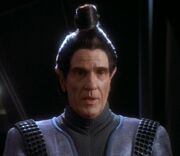
Sharat , a male Kellerun with a typical 24th century hairstyle
In the 24th century , Kelleruns tended to wear their hair in a topknot bun. ( DS9 : " Armageddon Game ")
The Ballad of Krul was a classic of Kellerun literature . ( DIS : " Mirrors ")
Kellerun boiled their cakes . One of their beverages was Kellerun citrus mash . ( DIS : " Mirrors ")
Individuals [ ]
- List of unnamed Kelleruns
Technology [ ]
- Kellerun phaser rifle
Appendices [ ]
Appearances [ ].
- " Armageddon Game "
- " Red Directive "
- " Under the Twin Moons "
- " Face the Strange "
- " Mirrors "
Background information [ ]
According to the script , the species' name was pronounced as "KELL-er-un".
The same script described: " In looks only, the T'Lani should be to the Kelleruns like the Vulcans are to the Klingons … the T'Lani look like the more peaceful race. " [1]
According to StarTrek.com , this species was native to the Alpha Quadrant. [2]
External link [ ]
- Kellerun at Memory Beta , the wiki for licensed Star Trek works

IMAGES
VIDEO
COMMENTS
54) describes Pike's encounter as the first contact with the species, details the Kalar as being the dominant species of Rigel VII and characterizes the world as being quarantined without any aligned political system, pending development of warp drive. Whereas Star Trek: Star Charts (p. 54) gives Rigel VII a population of 725,000, Star Trek ...
A Kalar warrior ( TOS 01) The Kalar were a humanoid species [1] native to Rigel VII. [2] The Kalar had a relatively primitive level of technology, and Captain Christopher Pike was forced to fight a Kalar warrior during a disastrous First Contact mission in 2254 that reportedly killed two of his crew, including his yeoman, and injured seven ...
Sci-fi. Star Trek. For the mirror universe counterpart, see Kaylar (mirror). The Kaylar, also called Kalar or Kalarans, were a pre-warp species inhabiting Rigel VII. They were a large and physically powerful people with an average height of over 2.5 meters and weighed over 150 kilograms.
The famous planet Rigel VII returns in Star Trek Strange New Worlds season 2 this week as the Paramount Plus show brings Captain Pike back to the purple planet. The Digital Fix. ... Rigel VII is inhabited by the native Kalar. The Kalar are a pre-warp species native to the planet who live in a caste system with one dominant warrior class.
This week, we go back to the very beginning of the Star Trek franchise as the show revisits a fearsome alien race. Spoilers ahead for Star Trek: Strange New Worlds season 2 episode 4, 'Among the Lotus Eaters.'. The real problem begins five years prior to Star Trek: Strange New Worlds, when Captain Pike and a landing party embarked on a routine ...
The Emissary: Directed by Cliff Bole. With Patrick Stewart, Jonathan Frakes, LeVar Burton, Michael Dorn. The Enterprise addresses the emergency of an old Klingon ship coming out of stasis and ready to fight the Federation. A half-Human/half Klingon emissary arrives to help, who once knew Worf intimately.
According to Star Trek: Star Charts (p. 54; "United Federation of Planets III"), Rigel VII (Beta Orionis A VII) was a quarantined planet. The planet was a class M world. The planet was non-aligned, with its status pending the development of warp drive. The dominant species was the Kalar. There was a conjectural count of 725,000 Kalar in 2370.
Notable Species: Kalar ... Rigel VII, a Class M world, was inhabited by a belligerent neanderthaloid race called the Kalar, which had a population of about 725,000. Notes and References. ↑ 1.0 1.1 Mandel, Geoffrey. Star Trek: Star Charts. Pocket Books, 2002. ↑ 2.0 2.1 Roddenberry, Gene (Executive Producer). "The Cage". Star Trek, season 0 ...
K'Ehleyr, the daughter of a Human mother and a Klingon father, was an ambassador and special emissary of the Federation in the 2360s. K'Ehleyr described herself as being "trapped between two cultures" with bi-racial parents. Having the humor of her mother and the temper from her father, she preferred her Human side and exercised tight control of her Klingon tendencies. Her Klingon side ...
The Kalar were a humanoid species native to Rigel VII. The Kalar had a relatively primitive level of technology, and Captain Christopher Pike was forced to fight a Kalar warrior during a disastrous first contact mission in 2196 that killed two of his crew, including his yeoman, and injured seven others, including Lieutenants Spock and Tyler.
The Kalar are a primitive species from Rigel IV who were forcibly relocated to Rigel VII by the final group, the Zami, who were a human-like species with slightly pointed ears.
Star Trek's Kalar Species Explained . Although it was a manifestation of Pike's memories, the Kalar soldier in Star Trek's "The Cage" appeared to be a feral barbarian, who was beyond reason.
Kalara is much older than when the events of Star Trek: Beyond takes place in the year 2263. She was born somewhere during the early to mid-22 nd century, which marked a significant period of change in the history of Earth, followed by other species in the galaxy. Given the fact that Edison was a Romulan war veteran, and Wolff his crewmate ...
Worf, son of Mogh is a fictional character in the Star Trek franchise, portrayed by actor Michael Dorn.He appears in the television series Star Trek: The Next Generation (TNG), seasons four through seven of Star Trek: Deep Space Nine (DS9) and the third and final season of Star Trek: Picard, as well as the feature films Star Trek Generations (1994), Star Trek: First Contact (1996), Star Trek ...
Early life and education. Born Susan Plaksin in Buffalo, New York, she was raised in Kingston, Pennsylvania, and attended Northwestern University. [citation needed]Career. Plakson began her career on the stage, and played four characters opposite Anthony Newley in the national revival tour of Stop the World, I Want to Get Off.She also played Marquise Theresa Du Parc in the Broadway production ...
According to the Star Trek expanded universe, there are six native species to the Rigel system: the Chelons or Chelarians from Rigel III, the human-like Rigelians (Kalar warriors) from Rigel VII, the Enterprise Rigelians, a race of Vulcanoids from Rigel V (the ones referred to in "Journey to Babel"), a rat-like species from Rigel IV, and a ...
First mentioned by Data in the Star Trek: The Next Generation episode The Loss, and then name-dropped again a few more times throughout the rest of TNG, it wasn't until Star Trek: Deep Space Nine ...
Suzie Plakson. Actress: Star Trek: Voyager. Suzie Plakson (born June 3, 1958) is an American actress, singer, writer and artist. Born in Buffalo, New York, she grew up in Kingston, Pennsylvania and went to college at Northwestern University. She began her career on the stage/theater, and played four characters opposite Anthony Newley in a revival tour of "Stop the World, I Want to Get Off".
The latest episode, "Mirrors," is no exception, as it brings back a famous Star Trek ship, as well as answers questions about a mysterious alien species, which has been around since the 1990s.
Detail of facial design. This species was identified on screen in DIS: "An Obol for Charon", previously only identified by production materials created for Star Trek: The Motion Picture.. The original Saurians were designed by Fred Phillips and Robert Fletcher for The Motion Picture.With the approval of Gene Roddenberry, the Saurians, as well as numerous other new species in the film, were ...
The Star Trek: Discovery episode "Mirrors" includes a HUGE reveal about the Breen, an odd alien species from Deep Space Nine. By Joe George | April 25, 2024 | Share on Facebook (opens in a new tab)
(Admittedly, this is also a Star Trek classic—Trek loves pointing at a single member of a species and tying their entire sociopolitical or theological systems to our understanding of their ...
A Kalar warrior (TOS 01) Species: Kalar: Sex: Male First Appearance: TOS 16 (24 Nov 1966) Portrayed by: Mike Dugan (Uncredited) Advertising: Amazon. Prime Timeline ... Star Trek, season 0, episode 0 (Production number 01). Directed by Robert Butler. Written by Gene Roddenberry. Released 1986.
"Star Trek" might represent an idealistic vision of a bolder and brighter future, but the last few seasons of "Discovery" have proven that there will always be bad guys with a penchant for ...
Star Trek: Discovery season 5, episode 5, "Mirrors," ends with Captain Michael Burnham (Sonequa Martin-Green) and the USS Discovery's crew grappling with jaw-dropping reveals about the Mirror Universe's ISS Enterprise, L'ak's (Elias Toufexis) species, and the next clue in the hunt for the Progenitors' treasure. Written by Johanna Lee and Carlos Cisco and directed by Jen McGowan, the thrilling ...
Star Trek: The Next Generation's Wesley Crusher (Wil Wheaton) is largely to blame for the creation of the Maquis terrorist organization.The Maquis were created for Star Trek: Voyager as the show wanted a rogue element among its crew, but the organization was seeded in TNG and the Star Trek: Deep Space Nine two-parter "The Maquis".Discussing the Maquis in the reference book Star Trek: The Next ...
A species or race was any class of lifeform that had common attributes and were designated by a common name. According to Data, "in the game of military brinksmanship, individual physical prowess is less important than the perception of a species as a whole." However, according to Worf, if "no one is willing to test that perception in combat [..] then the reputation means nothing." (TNG: "Peak ...
From the lack of galaxy-ending stakes and major interpersonal drama among the crew, Season 5 is Stark Trek: Discovery at its most fun. This episode, in particular, is full of classic Star Trek moments, from forcing enemies to work together to sci-fi technobabble that provides a dramatic resolution to a major problem. The impetus for this race for the Progenitors' technology stems from Star ...
Speed was always part of Saru's power set, which makes sense when framing Kelpiens as a prey species. In Star Trek: Discovery season 1, episode 8, "Si Vis Pacem, Para Bellum", the energy-based natives of the planet Pahvo use the full extent of Saru's physical abilities when Saru is under their control.One such ability is Saru's speed, which far exceeds that of Specialist Burnham and Lieutenant ...
The Kellerun were a humanoid species native to the Alpha Quadrant. In 2370, the war between the Kellerun and their neighboring enemies, the T'Lani, had just ended. The war had been marked by the use of a deadly chemical, known as the Harvester weapon. Both sides were determined to keep the hard fought peace they now enjoyed and decided to remove all records of the virus. This meant killing the ...